Brian Hazard of the project Color Theory details his experience running ads on Facebook to promote his music, and outlines some best practices for artists looking to do the same.
Guest post by Brian Hazard of Passive Promotion
Disclosure: This post may contain affiliate links, meaning I get a commission if you decide to make a purchase through my links, at no cost to you.
I’ve written about Facebook and Instagram ads for Spotify many times, like here, here, and this one from April of 2018 where I noted that I’d spent $5888.35 on Facebook ads to date.
Three years later, it’s $20,614.84.
While there are still useful angles to explore in those older articles, this post supersedes them. Not because they were necessarily wrong, but because the platform and practices have evolved.
For example, Instagram Stories was far and away the best ad placement for music two years ago. Viewers tend to be receptive to exploring new music and have their sound on.
The problem is most musicians know that by now. The resulting competition has driven ad costs up. Lately I’ve gotten cheaper followers through feed ads.
My Spotify following in March 2021
I’m spending $20 a day on Facebook ads, split between promoting my artist profile and my synthwave playlist.
I’m up to 9K profile followers and 17K playlist followers.

Every morning I track my follower growth in a spreadsheet. Here’s March so far (click to enlarge):
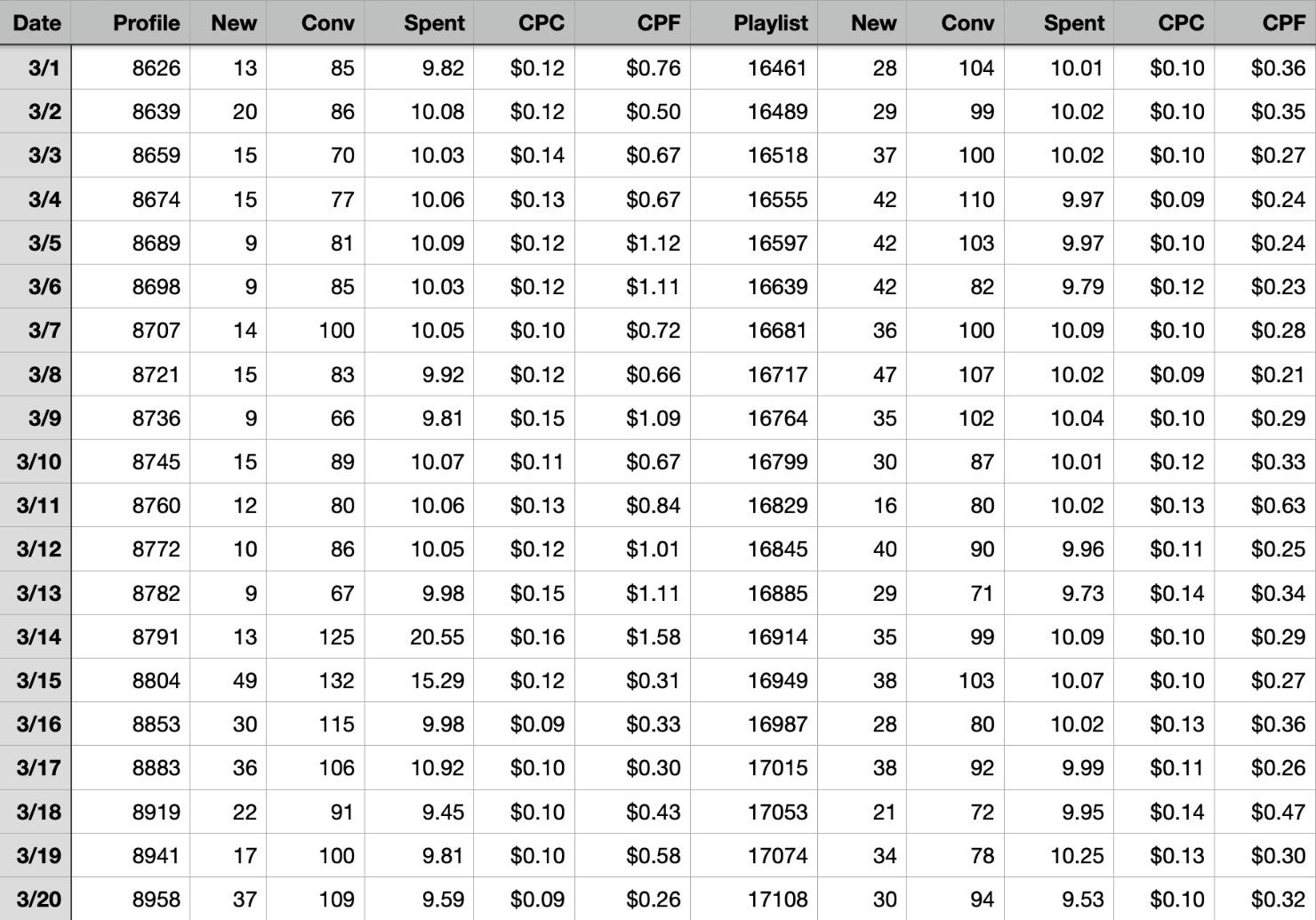
Right now, I’m paying about $0.30 per follower for both my profile and playlist.
The latter has been pretty stable, but the former is just starting to settle in since I added India last week. More on that later…
My current Facebook ads for Spotify
Here’s my current profile ad for feeds:
And my playlist ad for feeds:
Same audio! For whatever reason, this little snippet of the last verse going into the coda outperforms everything else I’ve tried.
You may have noticed my feed videos aren’t square. They’re actually 4:5 or 1080×1350. I render them at 2x (2160×2700) in ScreenFlow for retina screens, though I’m not sure it makes a difference after Facebook processes it.
The result takes up more screen real estate on mobile, at the cost of black bars on desktop:

I get very few conversions on desktop, even with square video, so it’s totally worth it.
My stories ads are 9:16 (2160×3840) and are basically the same as the feed ads but with an added prompt to “swipe up to follow.”
I run both variations in a single ad using the “edit placement” function:
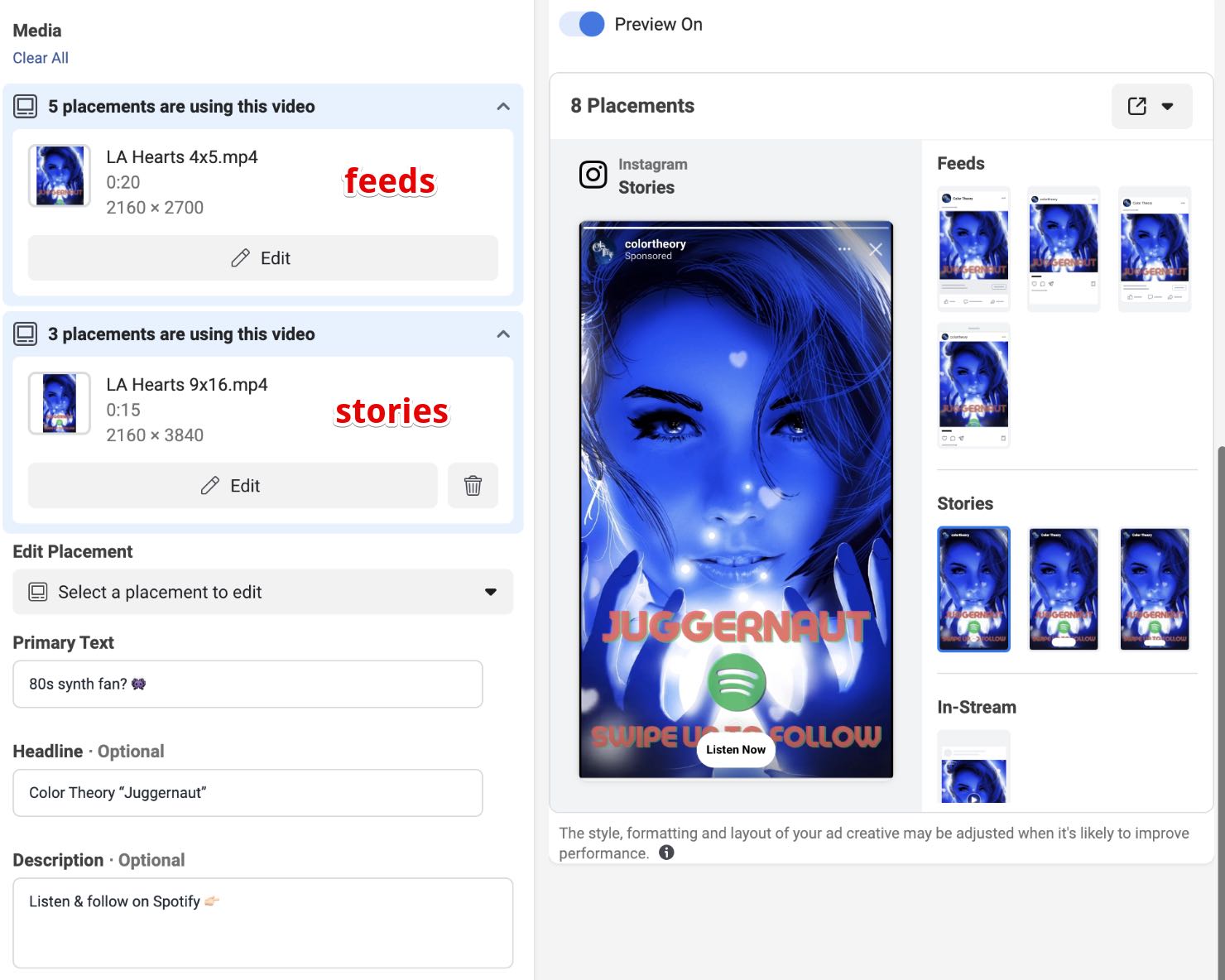
The eight placements I’m running are Facebook News Feed + Video Feeds + In-Stream Videos, Instagram Feed + Explore, and all three Stories options.
It doesn’t really matter though. As long as you don’t waste your money on Audience Network, Facebook will optimize for the best performers.
My profile ads dominate in IG feeds, but my playlist ads do better on Facebook (click to enlarge):
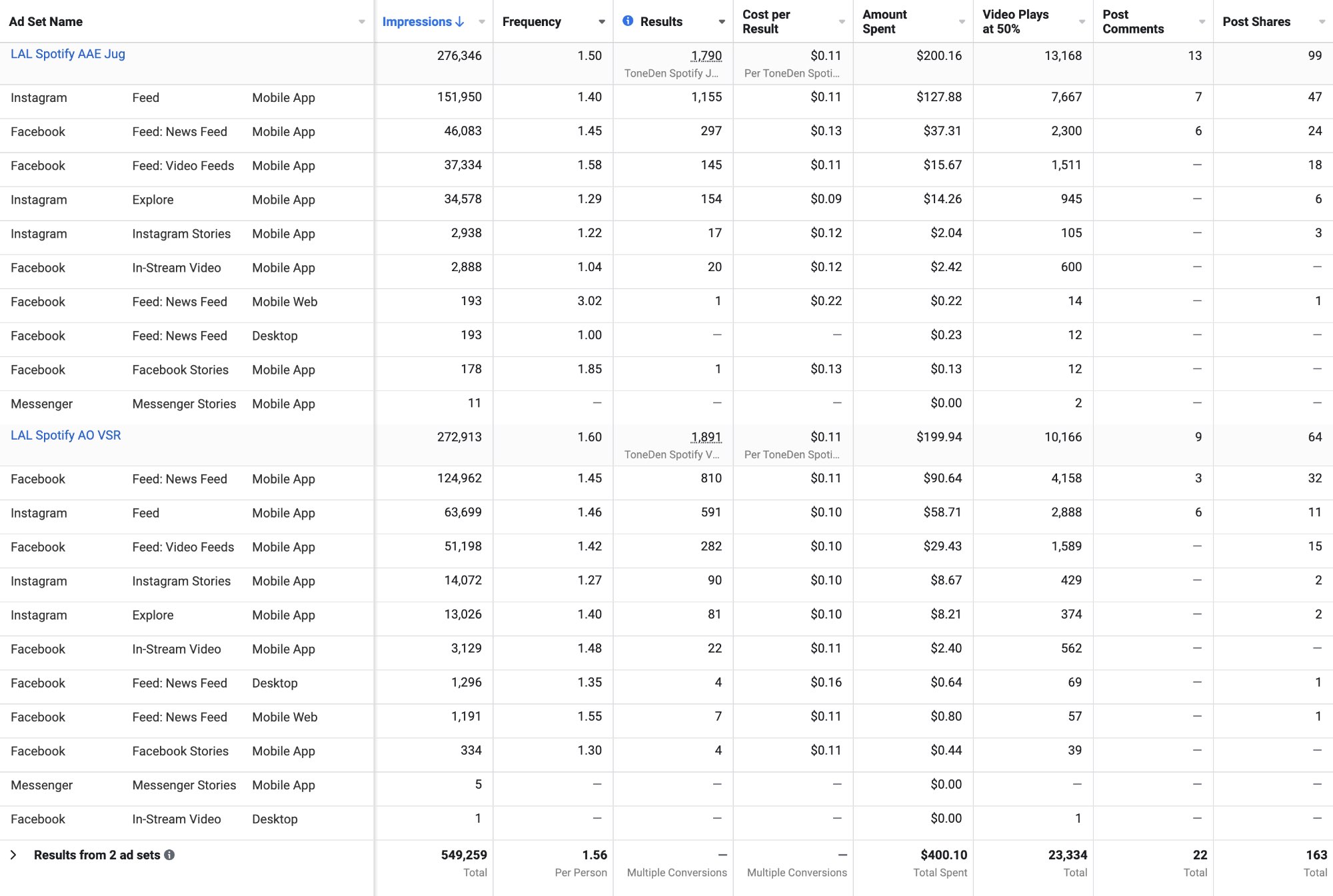
Facebook Ads for Spotify Targeting
I target all Spotify countries, divvying them up between my profile and playlist ads so they don’t compete against each other in the auction.
The playlist ad hits the Americas plus Oceania, which roughly translates to Mexico and Brazil (click to enlarge):

The profile ad delivers to the rest of the world. Mostly Russia, but India will surely overtake it soon:

Up until last week, my ads wouldn’t run to India, and I couldn’t figure out why until Facebook support told me:
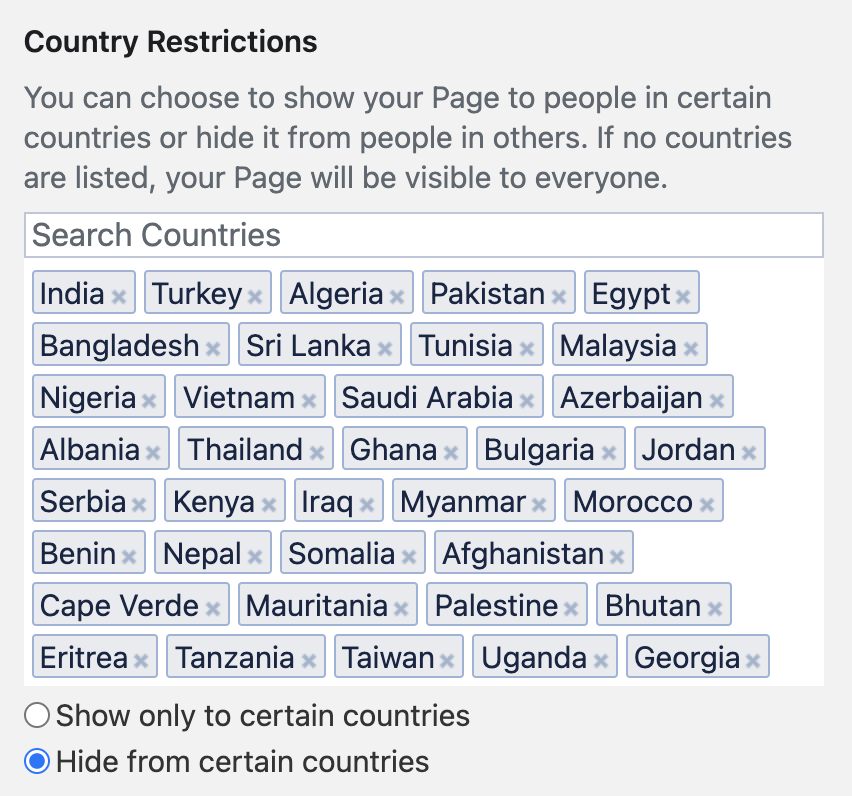
At some point, I must have blocked a bunch of countries from viewing my page’s content.
Since removing all country restrictions, most of my profile conversions are coming from India. I’m good with that! Spotify for Artists confirms that they’re actually listening to the track:
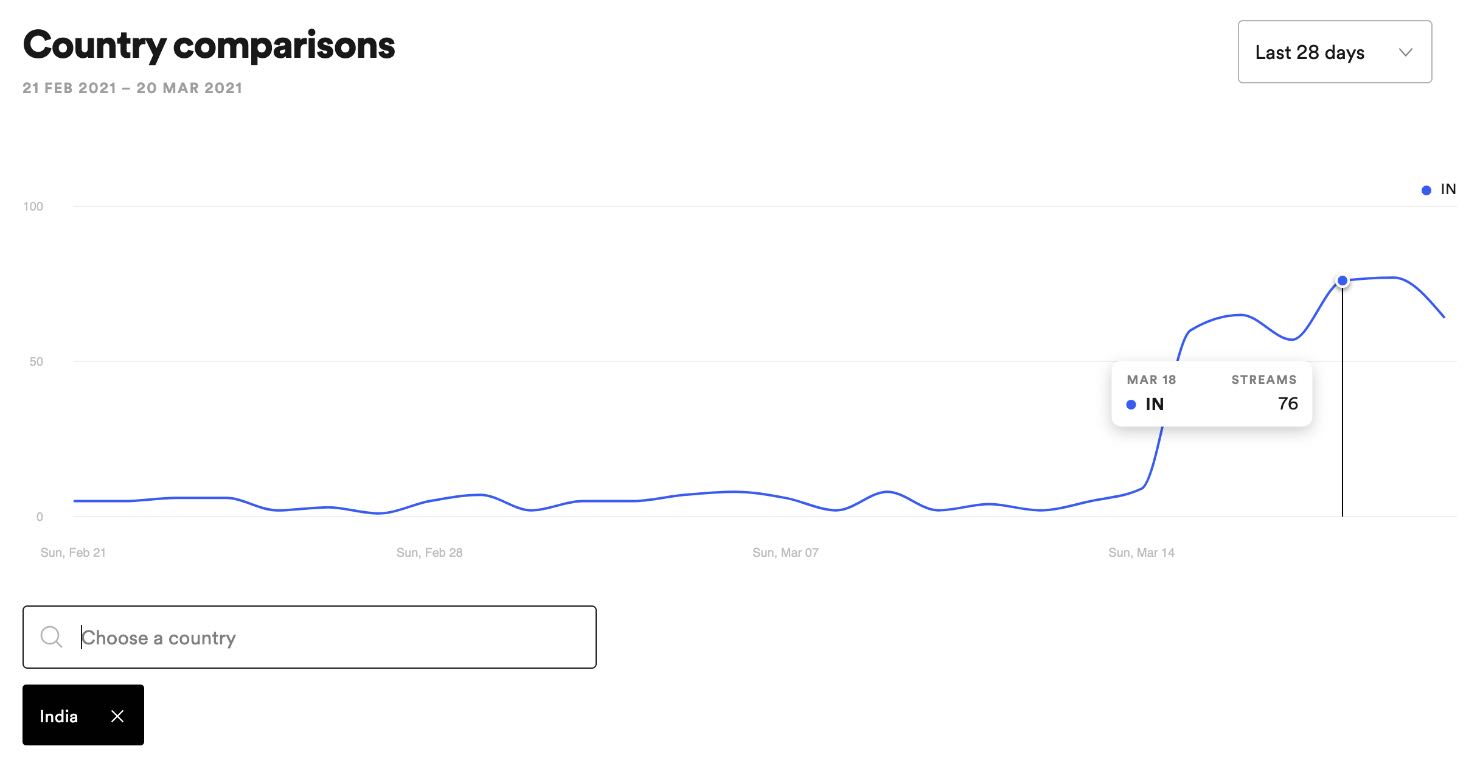
That’s not always the case though. The $6.55 I’ve spent so far this month on Algeria doesn’t appear to be paying off, so I may drop it:
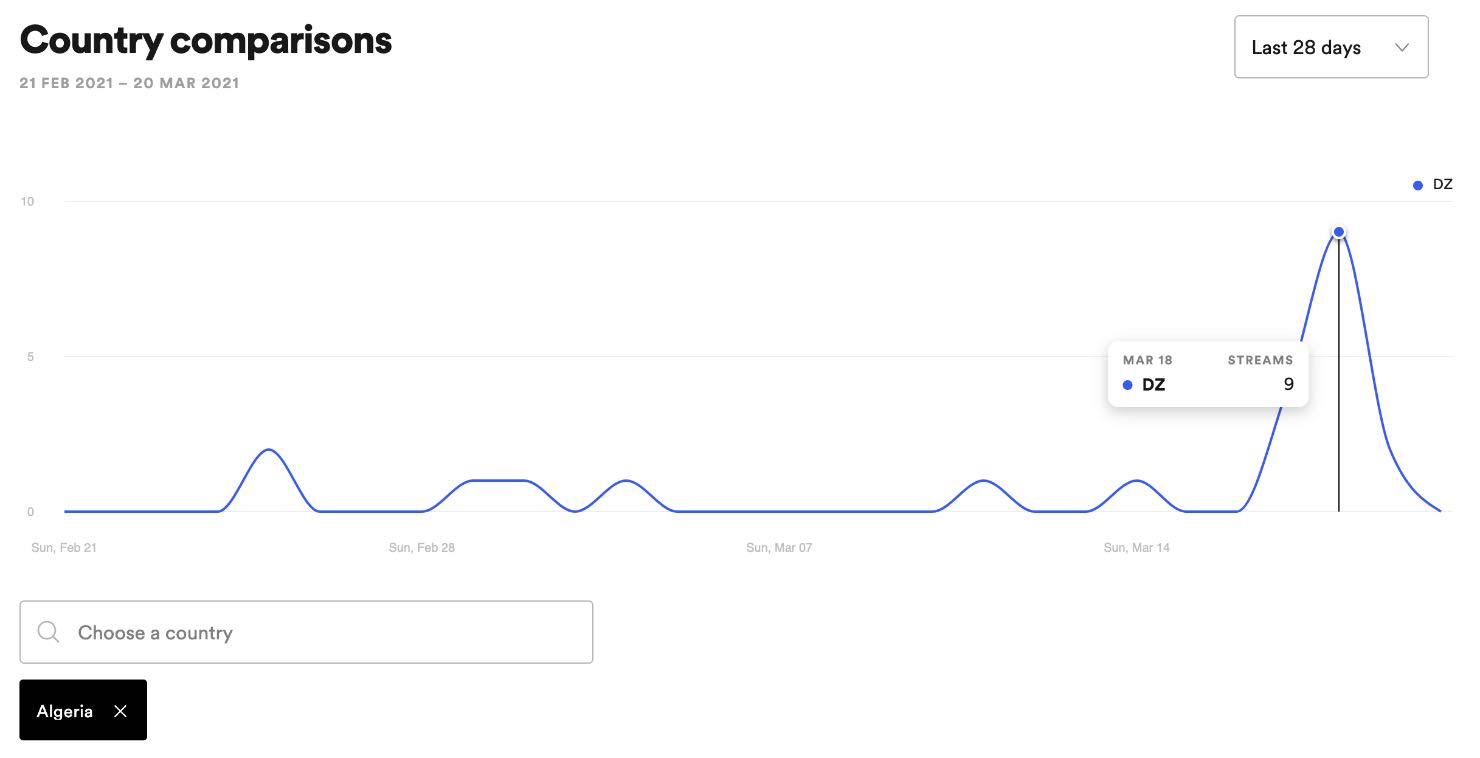
I’ve already dumped Ukraine, Kazakhstan, and Indonesia for the same reason.
Considering where my ads are being shown, you’d think that my Spotify Top Countries would be Mexico, Brazil, and Russia. Nope! I have more listeners in the US than those three countries combined:

By now you’ve probably heard of the whole “trigger cities” concept. By advertising in cities that have high music consumption and low advertising rates, you trigger the Spotify recommendation engine, resulting in more algorithmic streams worldwide.
I’ve never zeroed in on specific cities, and I can’t prove that the underlying assumption is correct, but I can testify that 15% of my streams, 8.5K in the past 28 days, are from algorithmic playlists.
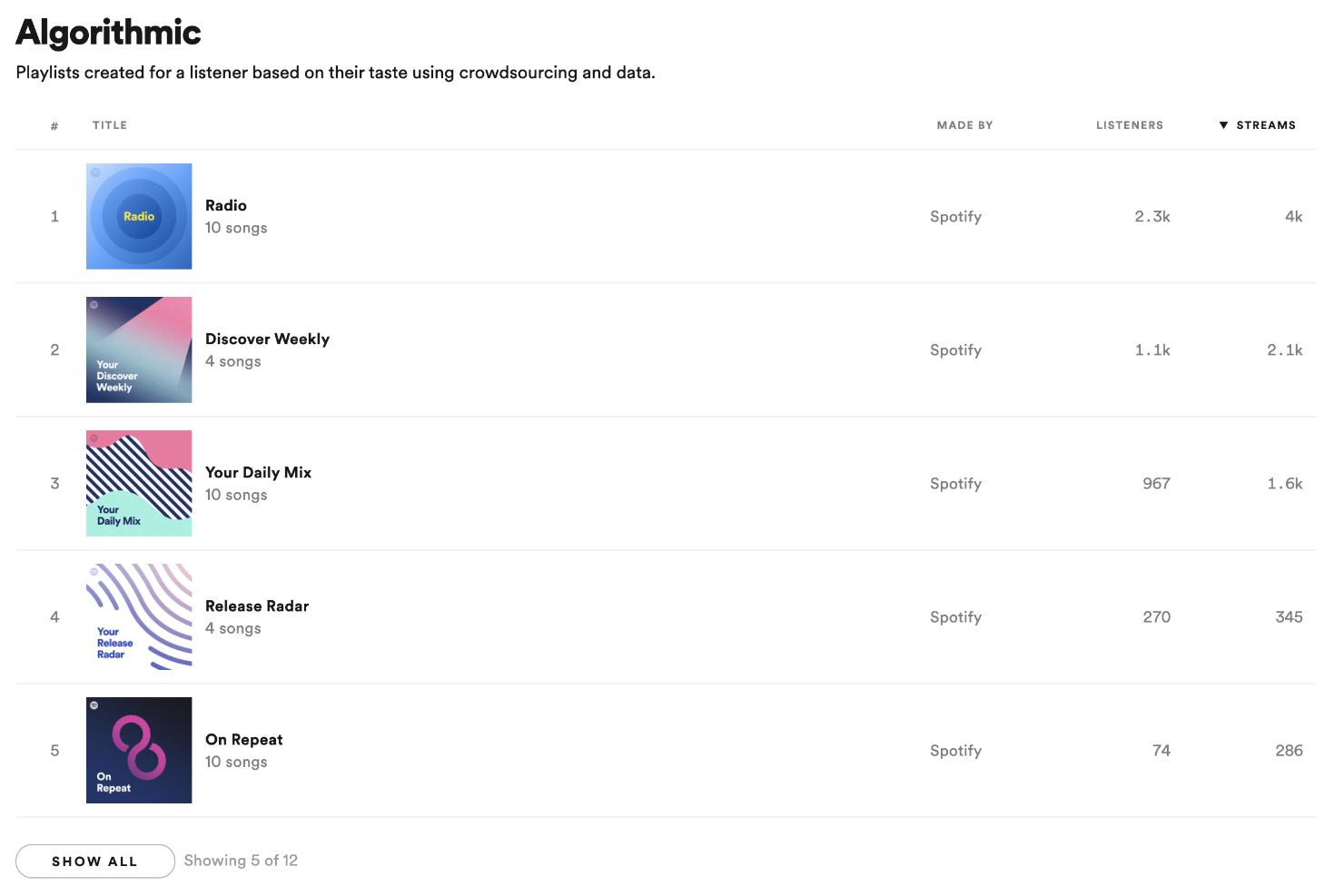
Conversions Objective Setup and iOS 14
I’ve described where I’m targeting, but not who. I’m targeting a lookalike audience of users who previously clicked through to Spotify from my ToneDen landing page, which looks like this:
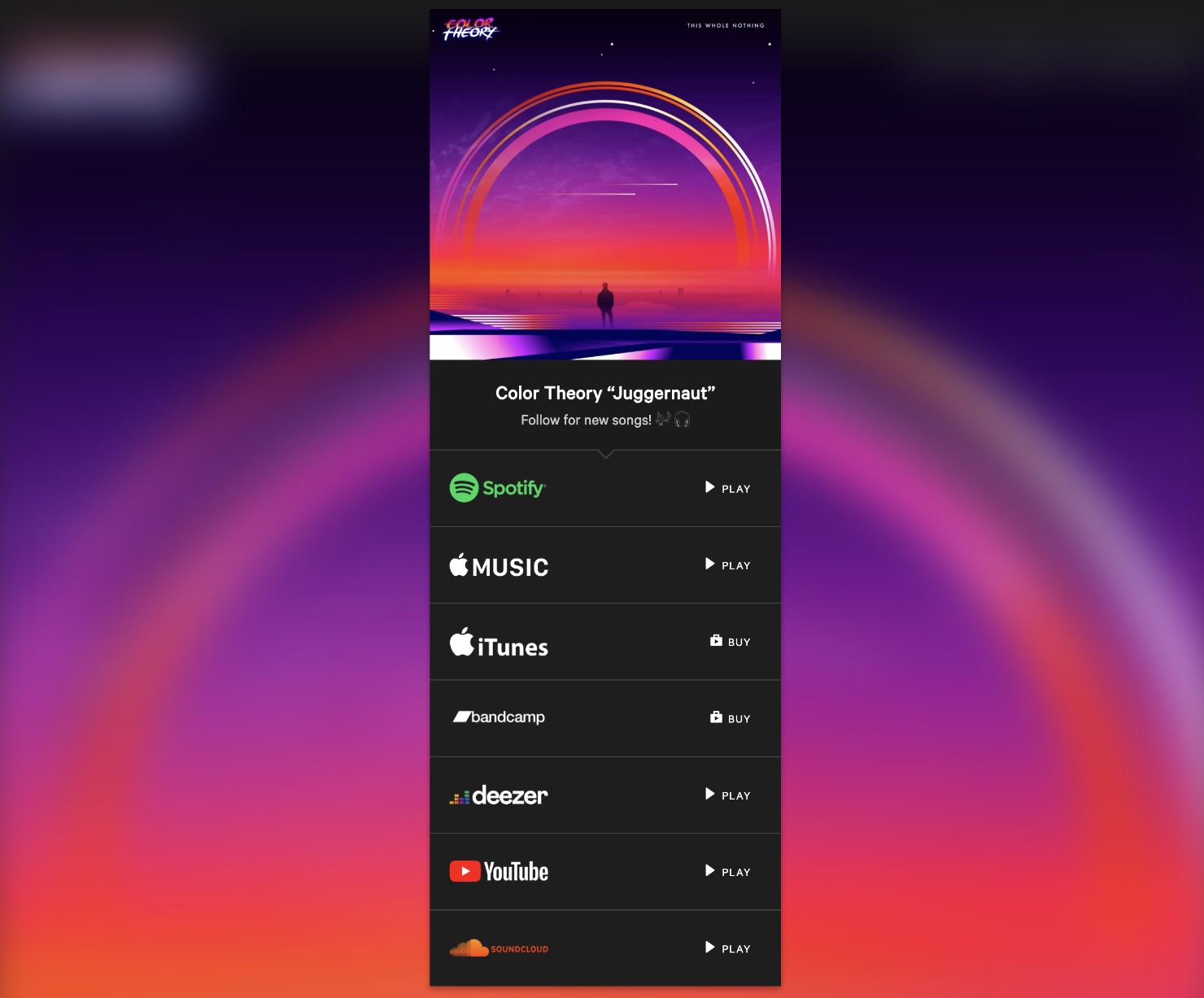
I optimize for Spotify clicks using a custom conversion:

You might be wondering; don’t I want YouTube and SoundCloud plays too? Sure, but I don’t want Facebook to optimize for them! I can already get YouTube views for far less.
Explaining how to set everything up in the midst of iOS 14 changes would take its own quite boring post. Before you can configure your ad, you have to verify your domain, create the custom conversion, add it to Business Settings, and configure the web event in Aggregated Events Management.
And before all of that, you have to host the link on a domain you own, which took me five minutes with ToneDen. Just go to Settings/Advertising, click on “Add Domain,” enter a subdomain, then add a CNAME DNS record at your hosting service:

Now all my go.colortheory.com links direct to ToneDen. You can do the same with Feature.fm and Hypeddit.
If this all sounds too technical, I recommend John Gold’s Spotify Growth Engine. It’s dirt cheap through my link, and John hosts a weekly coaching call and Facebook Group where you can ask questions if you get stuck.
So again, I’m targeting a lookalike audience of users who already performed my desired action: clicking through to Spotify. Of course, I didn’t have that audience to begin with, so I started by targeting a lookalike of 75% video viewers.
My only other restriction, which is hardly a restriction at all, is setting the age range to 16-64.
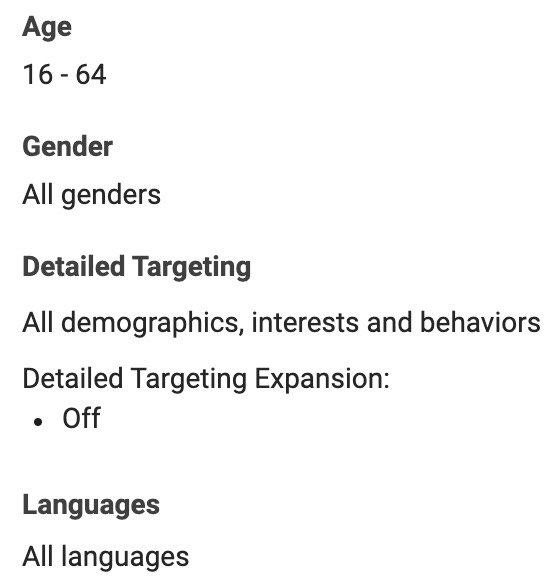
So that’s my current playbook, honed from months of careful testing. In the near future, I’ll swap my profile and playlist targeting and retarget users who watched 50% of the prior ad. In other words, I’ll show the playlist ad to users who already watched half of the profile ad, and vice versa.
Beyond that, I’ve got a laundry list of further ideas to try out, and a list of conclusions I’ve drawn so far, which I’ll expand on now.
Facebook Ads for Spotify Dos and Don’ts
Without further preamble, here are my best practices for Facebook and Instagram ads to grow your Spotify following:
DO visit Facebook Ad Library for inspiration
Did you know you can view anyone’s ads? You should absolutely explore how other artists in your genre promote their music.
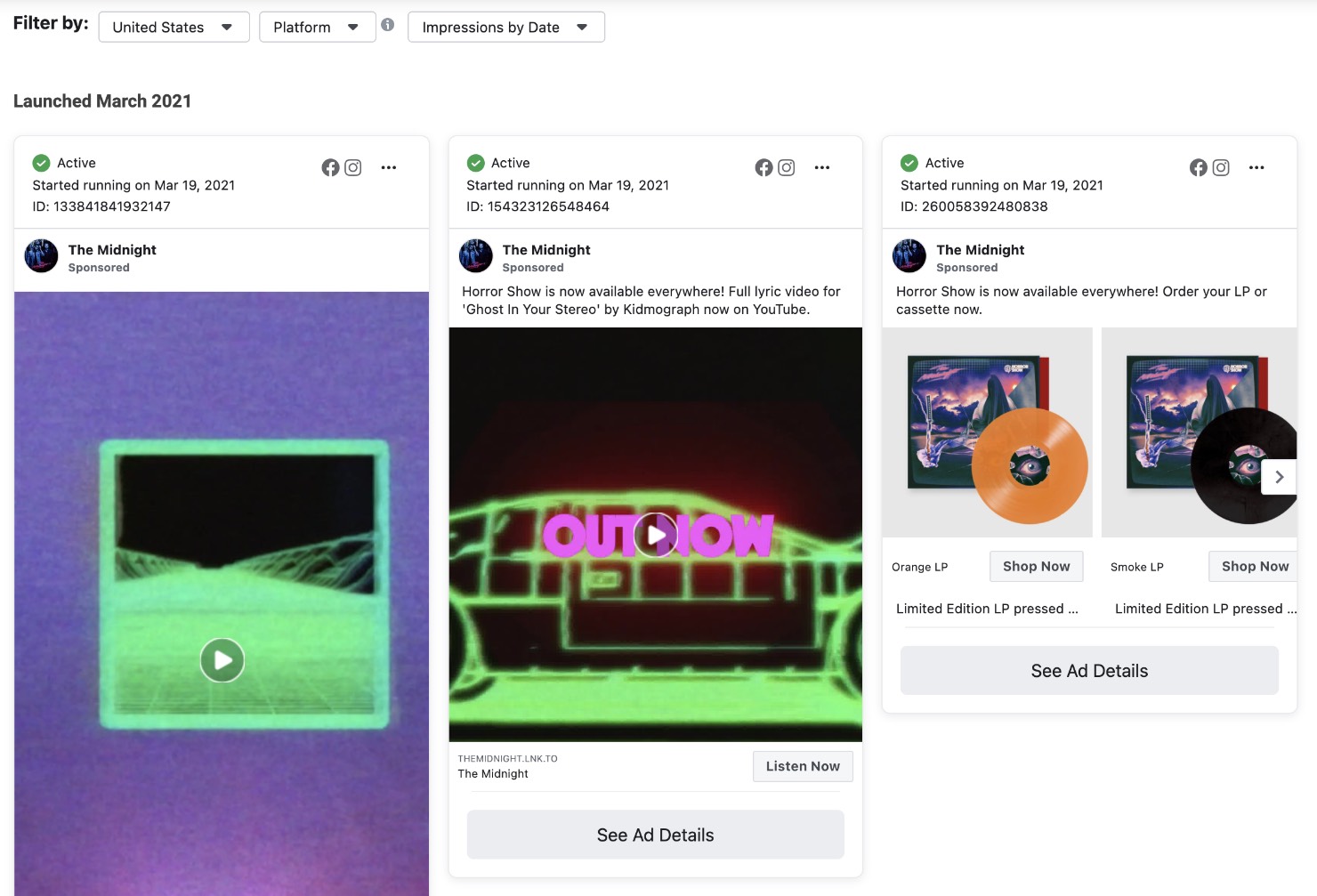
If you see a blank page, click on “All Ads.” It defaults to politics for some reason, for me anyway.

DO keep your ads simple and direct
I’ve tried animations, Spotify canvases, and official music videos. None of them work as well as the simple images you see in the examples above, with subtle animated overlays courtesy of the Motionleap app on my phone.
DO include the Spotify logo
The Spotify logo instantly tells users what your ad is about and lessens the chance that they click through just because they like the pretty picture. You only want to pay for, and optimize for, Spotify users.
You can grab the Spotify logo as a transparent PNG from me here.
DO use Dynamic Creative to test headline, text, and description
Believe me, you can do better than “Out now on all major platforms!” I’ve found that “Listen now on Spotify ” is a solid choice for a description. If Facebook doesn’t think displaying the description will help, it won’t show it to the user.

Oftentimes the best text is no text, especially in countries where English isn’t the primary language. You can test it by leaving the first option blank.

When in doubt, tell users what you want them to do, i.e. “Listen & follow on Spotify.”
DO experiment with Detailed Targeting Expansion and Lookalike Expansion
Lookalike Expansion always seems to help, even when it pushes the audience size into the tens of millions. Still, I don’t enable it right away, because I don’t want to risk optimizing for bots.
Detailed Targeting Expansion comes in handy for broadening a very narrow audience. Here’s one of my favorites:
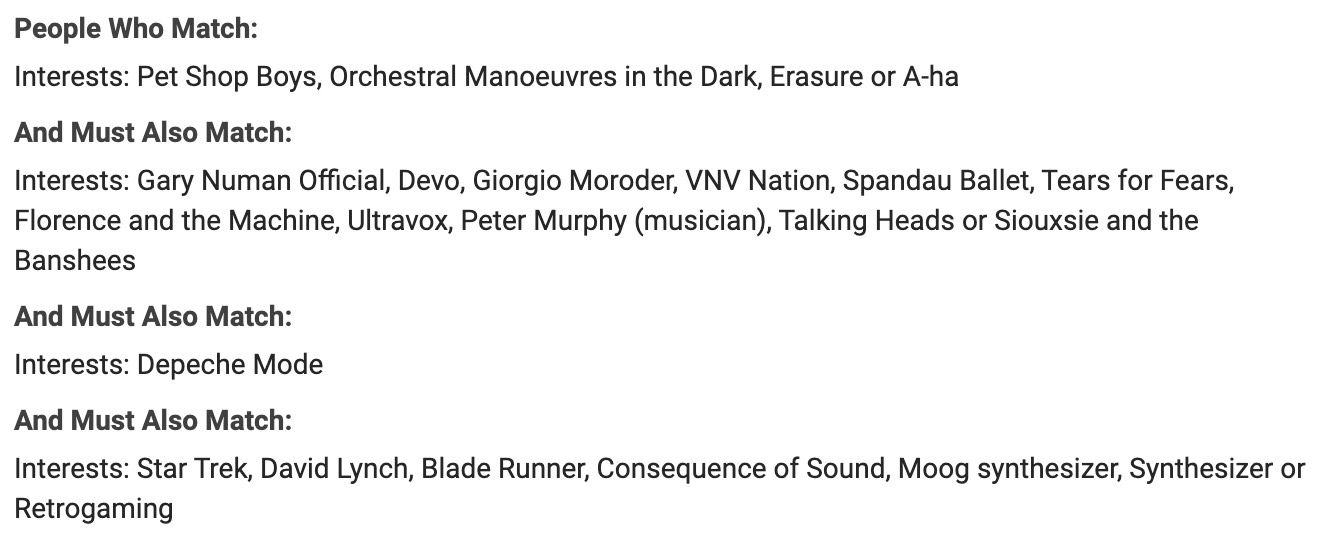
For this campaign, I’d also throw in “And Must Also Match: Spotify.”
Depending on your age, gender, and geographic targeting, your potential reach could be in the low thousands or worse. Detailed Targeting Expansion can bring that up to a reasonable range, ideally 1-3M.
Again, it’s best to wait until you need it, like when the ad frequency gets above 1.5 or so. If your audience size is already workable, there’s no need to risk showing ads to users who may not have Spotify.
DO test different video lengths
Stories ads are limited to 15 seconds, but your feed ads can be as long as you want. I didn’t see a big difference going from 20 seconds all the way up to a minute, but I suspect it depends on the song.
I suggest ending the ad on an unresolved chord or phrase. It may encourage users to click through to “close the loop.”
DON’T bid against yourself in the auction
If you have multiple ad groups with overlapping audiences, you’ll bid against yourself in the auction, and your cost will go up.
The way to check is to hover under the ad set name and select “Inspect”:
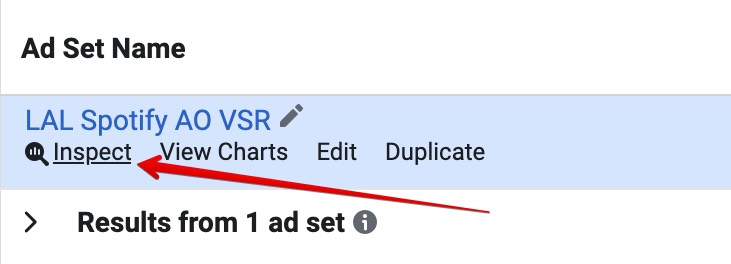
If you don’t see 0% auction overlap, you’re doing it wrong.

An easy way to remedy overlap is to exclude every ad set’s audience from the rest.

For example, if you’ve got one ad group targeting Depeche Mode fans and another ad group targeting Electronica, you’ll almost certainly have overlap. You can see exactly how much in Audiences by building the two audiences and selecting “Show Audience Overlap.”
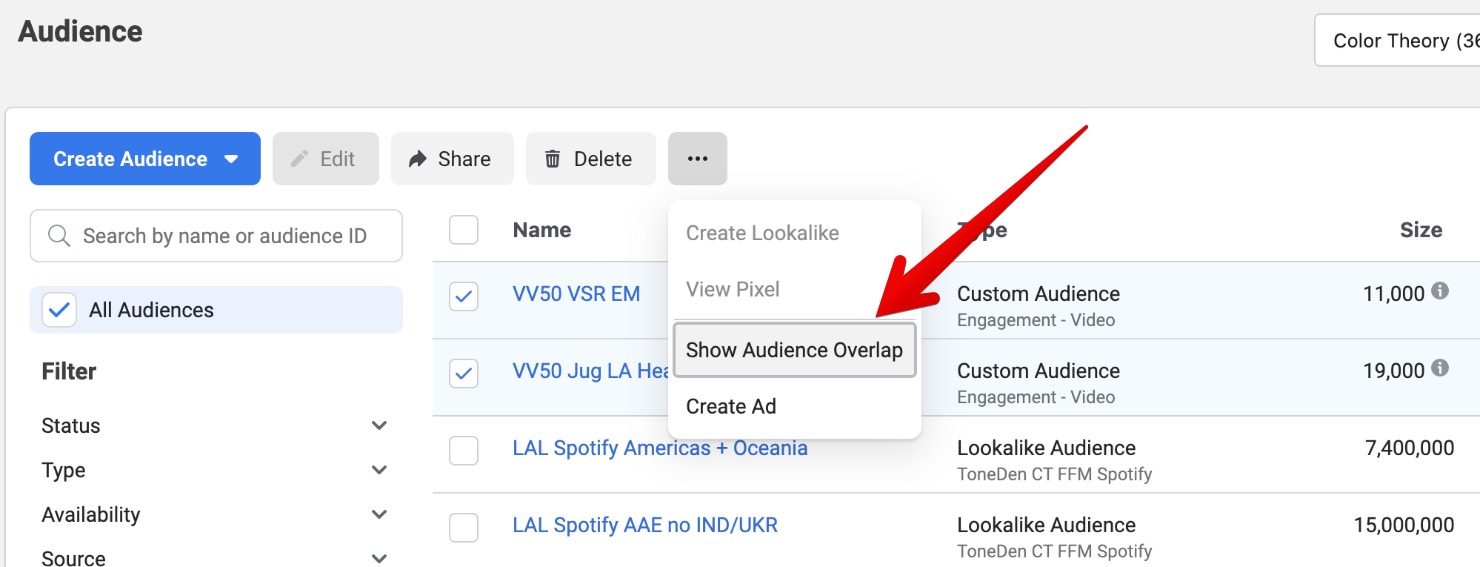
To remove the overlap, you exclude Depeche Mode from the Electronica ad group, and exclude Electronica from the Depeche Mode ad group.
DON’T forget that social proof is a factor
My ads have hundreds of likes, dozens of shares, and a handful of nice comments. That social proof is enough to outperform a 10% better ad.
If you’re always testing new ads, you’ll never reap the rewards of social proof. Sometimes the best ad is just “good enough.”
This works both ways. One insightfully mocking comment can torpedo your entire campaign, so be sure to keep an eye on your feed ads on both platforms, and reply to comments.
DON’T violate Facebook policies, even when you know you’re not
For years, my profile ad used the same image as my playlist ad. One day Facebook decided it was “shocking.” I appealed and they upheld their decision to not let me run the ad.
I could’ve made an imperceptible tweak and uploaded the video again, but I decided it wasn’t worth the risk.
A friend’s entire ad account was recently disabled for no reason we can fathom, using the same techniques and structure I outline here. No ad was ever rejected, no policy ever violated.
Still, the appeal was denied, and a half dozen requests for clarification yielded nothing but canned responses.
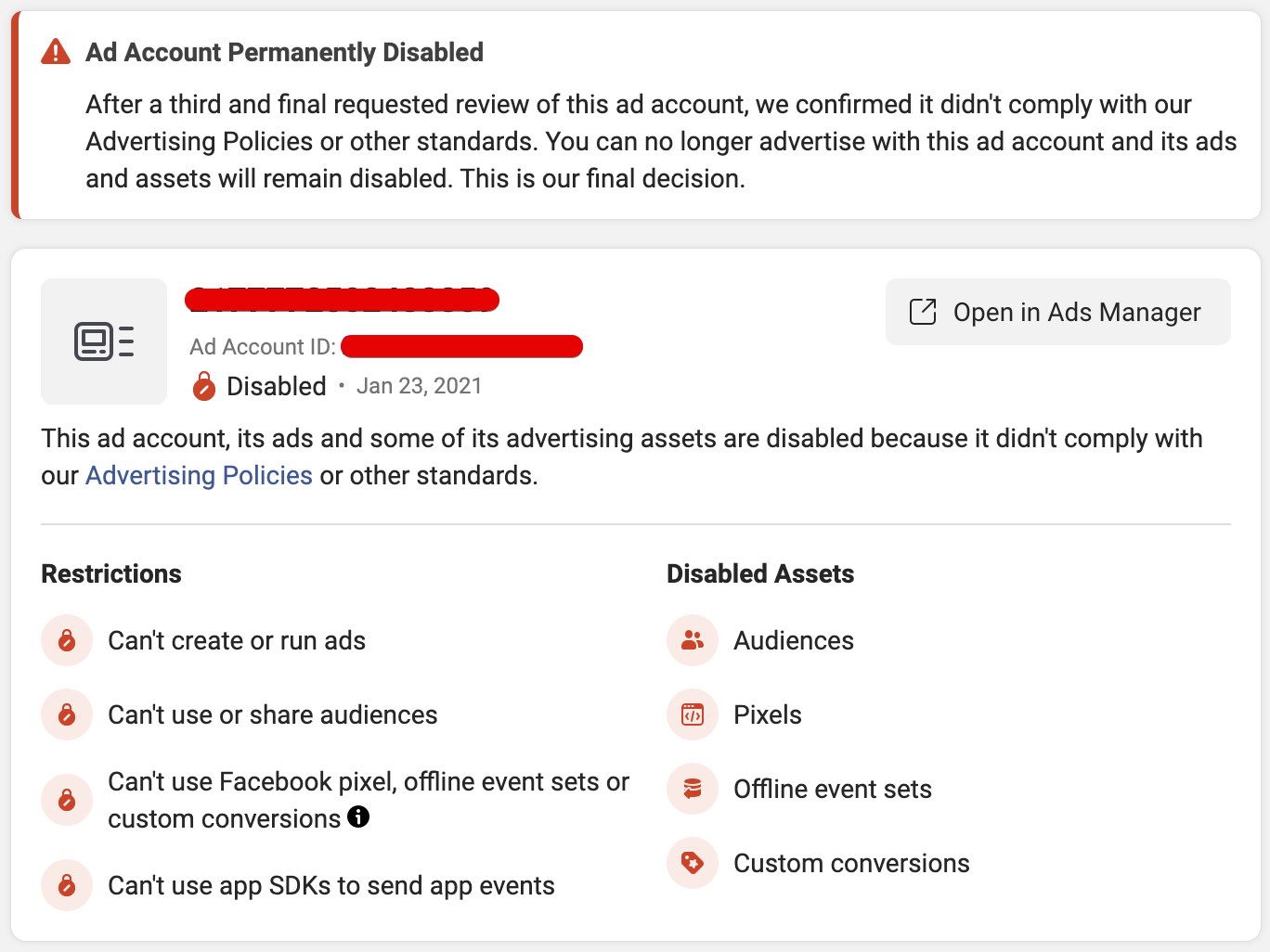
My advice is: don’t push your luck. Even if you know you’re in the right, assume that you won’t be able to make your case to a fellow human being.
Now let’s get out there and waste some money!
Is it smart to throw our money into the data black hole that is Spotify?
Probably not. Are we going to do it anyway?
You bet we are.
I’m spending $600 a month on ads to Spotify and getting $300 back in royalties. I’ve built a finely tuned money-losing machine!
To be fair, I’m also getting 150 Facebook and 150 Instagram followers every month.
Sure, I could be devoting that $600 to selling CDs or running another free + s/h funnel, but growing my Spotify audience is addictive.
Let’s start with the obvious. Tens of thousands of people are hearing my music every month on Spotify. That’s too many for my brain to keep track of. It’s literally mind-blowing!
It’s also incredibly gratifying. That’s the whole point of making music, right? For people to hear it.
To the listening public, an artist’s monthly listener count is the primary measure of their success. If it’s too low, many won’t listen in the first place.
I don’t know who these Spotify listeners are, and I have no way to reach them, yet I can watch my listener count on my phone in real-time.
I don’t know if Spotify gamified their artist platform intentionally, but it sure feels like it!
And so, against my better judgment, I persist in the Spotify ads game. I’ll continue to report my results so that you can do the same.
What’s working for you? Anything you’d like me to test? Let’s strategize in the comments!
Brian Hazard is a recording artist with over twenty years of experience promoting his eleven Color Theory albums, and head mastering engineer and owner of Resonance Mastering in Huntington Beach, California.
His Passive Promotion blog emphasizes “set it and forget it” methods of music promotion.
Catch more of his promotional escapades in his How I’m Promoting My Music This Month email newsletter.





























